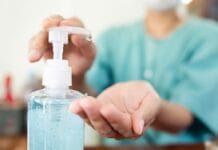Infection control has always been a top priority for dental hygienists. After all, it is vital to create a safe treatment environment for patients and hygienists alike. However, some dental hygienists mistakenly endanger themselves and their patients by failing to update their protocols and best practices. After writing my previous article on infection control mistakes, I received a plethora of responses from hygienists who wanted me to address additional infection control errors. Below are five more infection control mistakes that hygienists could easily make without realizing that they are actually posing a threat to themselves and their patients.
Mistake #1: Using gauze pre-soaked in disinfectant to wipe down equipment.
Neither the Organization for Asepsis and Prevention (OSAP) or the Centers for Disease Control and Prevention (CDC) recommends soaking gauze in disinfectant. (4, 5). While using gauze pre-soaked in disinfectant might seem like an effective means of cleaning equipment, studies cited by the CDC have shown that there are several reasons why this practice is dangerous:
- The cotton fibers in gauze can absorb and deactivate the active agents in disinfectants. (8).
- Quaternary ammonium disinfectant is 40%-50% less effective after just one hour of soaking. (4).
- Gram-negative bacteria can survive and multiply when other disinfectants are soaked in gauze. (4).
OSAP suggests that anyone planning to soak gauze with disinfectant should saturate the gauze at the time of use. (5). To be very clear, these guidelines pertain to soaking gauze; it does not pertain to pre-soaked, ready-to-use disinfecting wipes in the original manufacturer’s container. Additionally, gauze and disinfectants should be used according to manufacturer’s instructions. By heeding these suggestions, you can avoid putting patients at an increased risk for cross-contamination.
Mistake #2: Wearing artificial nails or failing to keep nails short and unpainted.
Keeping your nails short is not mandated by the CDC. However, most of the flora found on hands is concentrated around or under the fingernails. (3). Accordingly, the CDC recommends that hygienists keep their nails short enough to enable clinicians to clean underneath them easily. You should also keep your nails short because long nails can make it difficult to put on gloves and can compromise their integrity, potentially leading to tears. (4). Micro-tears in clinician’s gloves caused by long fingernails are so small; they may not even be apparent via visual inspection.
Fewer studies have been conducted on the risks of wearing artificial nails in dentistry professions. However, artificial nails have been linked to numerous outbreaks of bacterial and fungal infections in hospital settings. (2). Additionally, researchers have found that artificial nail wearers have higher levels of gram-negative bacteria than non-wearers, even after washing their hands. (2, 4). For these reasons, it is wise to refrain from wearing artificial nails.
In addition to maintaining short nails and avoiding artificial nails, hygienists should avoid wearing nail polish. While freshly applied nail polish on short nails is not linked to increased bacteria around the fingernail area, chipped nail polish can harbor bacteria. (2,4). Since there is no way to prevent nail polish from chipping, the CDC strongly recommends keeping your nails short and free of polish.
Mistake #3: Failing to change ultrasonic cleaner solution at least once per day.
A study conducted by Sultan Healthcare, a leading manufacturer of quality infection control products, yielded some startling findings regarding ultrasonic cleaning. The study found that roughly one in four dental practices do not change their ultrasonic cleaning solution frequently enough. (10). Below are some key points to remember to minimize bacterial contamination during the ultrasonic cleaning process:
- Ultrasonic cleaning solution should be changed more frequently if it becomes cloudy or murky.
- Be sure to close the lid when operating your ultrasonic cleaner or you could inhale harmful aerosols.
- Any old ultrasonic solution should be discarded in accordance with manufacturer instructions. (4).
- Allow the ultrasonic cleaner container to fully dry before reusing it. (4).
Fortunately, you can avoid ultrasonic cleaning mistakes by adhering to manufacturer instructions. Unless the manufacturer instructions for your ultrasonic cleaner solution clearly states that you can use the same solution for several days in a row, you should change the solution at least once each day. And remember to keep the lid on your cleaner closed to avoid inhaling aerosols that may contain contaminated particles.
Mistake #4: Taking extra infection control precautions with patients who have HIV or AIDS.
Treating a patient with HIV or AIDS differently is unethical, unlawful, and discriminatory. You cannot treat HIV/AIDS patients only at certain times, only on certain days, treat them in different operatories, or refer them because you feel “uncomfortable” treating them. According to a study released by The Williams Institute, 5% of dental practices in Los Angeles refused to offer dental care to People Living with HIV/AIDS (PLWHA). (9). These findings may seem surprising to Americans who think that discrimination against HIV/AIDS patients no longer exists. In spite of the fact that the Americans with Disabilities Act of 1990 covers HIV/AIDS patients, there continue to be complaints filed against dentists that result in costly settlements of up to $50,000. Below are some factors to consider when treating HIV/AIDS patients:
- The CDC indicates that the transmission of HIV is very rare. (4).
- HIV/AIDS is not on a list of conditions or diseases that dental care providers are at risk for acquiring.
- Global studies show that the risk of HIV transmission after exposure to infected blood is 0.3%. (4).
- The risk of HIV transmission after exposure to mucous membranes is 0.1%. (4).
- The risk of transmitting Hepatitis C through a single percutaneous exposure to blood is roughly 10 times higher than that of HIV. (1).
- The risk of transmitting Hepatitis B through a single percutaneous exposure to blood is about 100 times higher than that of HIV. (1).
Dental care providers can avoid discriminating against HIV/AIDS patients by doing two simple things. First, they should treat every patient equally. Second, they should adhere to standard precautions when treating patients. Abiding by standard precautions means that all patients are treated as if they have an infection, regardless of whether they disclose the presence of any infection. In short, there should be no change in protocol when treating HIV/AIDS patients. No double gloving, no disinfecting your operatory or sterilizing instruments any differently than someone who didn’t check the HIV/AIDS box on their health history. To do so is discrimination which is highly illegal and simply unethical.
With this said, the only modifications to treating patients with HIV/AIDS should be based on their health. For instance, knowing their INR count to account for bleeding risk or blood counts indicating immunosuppression.
Mistake #5: Reusing disposable items or single-use products.
Reusing disposable or single-use products is a practice that is typically undertaken in an effort to control costs. However, there are a number of reasons why clinicians should always follow the manufacturer’s instructions and refrain from reusing disposable or single-use items. A few of these reasons are as follows:
- Disposable items may deteriorate after use, potentially leading to breakage during treatment. (4).
- Reusing disposable sterilization pouches impedes their ability to keep instruments sterile. (6,7).
- Single-use items in dentistry are often not heat-tolerant, preventing proper sterilization. (4).
Though they aren’t a direct patient care item, reusing disposable sterilization pouches, isn’t okay either. They simply aren’t meant to be reused, nor are they designed for reuse or FDA registered for reuse. (6, 7). Loss of chemical indicator ability, insecure sealing of the pouch, and the ability of the pouch to maintain the sterility are al hindered by reusing sterilization pouches. (6, 7).
Avoiding this mistake is as simple as following a short set of instructions. If a manufacturer states that a product is a disposable or single-use item, then it should only be used once. There are no exceptions to this recommendation.
The Bottom Line
Dental hygienists and other dental professionals should never allow the desire to cut costs or failure to follow manufacturer instructions to compromise their own safety or the safety of patients. I urge you to take the time to review the 2016 CDC Summary of Infection Prevention Practices in Dental Settings (3) and the 2003 CDC’s Guidelines for Infection Control in Dental Health-Care Settings (4). The Summary is particularly useful, as it features helpful checklists that your office can use to make sure that your staff is employing the proper infection control practices. The 2003 CDC Guidelines include detailed answers to virtually every infection control question you may have. By going directly to the source of industry regulations and protocols, you can ensure that you receive the most accurate responses to all of your infection control questions.
Now Listen to the Today’s RDH Dental Hygiene Podcast Below:
References
- Abel, S.N., et al. (2000). Dental Alliance for AIDS/HIV Care. Principles of Oral Health Management for the HIV/AIDS Patient. Retrieved from https://aidsetc.org/sites/default/files/resources_files/Princ_Oral_Health_HIV.pdf
- Centers for Disease Control and Prevention. Guideline for Hand Hygiene in Health-Care Settings. MMWR 2002; 51 (No. RR-16). Retrieved from http://www.cdc.gov/mmwr/PDF/rr/rr5116.pdf
- Centers for Disease Control and Prevention. (2016, March). Summary of Infection Prevention Practices in Dental Settings: Basic Expectations for Safe Care. Retrieved from http://www.cdc.gov/oralhealth/infectioncontrol/pdf/safe-care.pdf
- Kohn, W.G., Collins, A.S., Cleveland, J.L., Harte, J.A., Eklunt, K.J., Malvitz, D.M. Center for Disease Control and Prevention. Guidelines for Infection Control in Dental Health-Care Settings – 2003. MMWR 2003; 52 (Report No. 17). Retrieved from http://www.cdc.gov/mmwr/PDF/rr/rr5217.pdf
- Organization for Asepsis and Prevention (OSAP). Frequently Asked Questions on Dental Infection Control. Retrieved from http://www.osap.org/?FAQ_Instrum_Disinf1#ireadrecently
- Organization for Asepsis and Prevention (OSAP). Frequently Asked Questions Instrument Sterilization. Retrieved from http://www.osap.org/?FAQ_Instrum_Ster2#agraduate
- Robinson, D.S., Bird, D.L. (2013). Essentials of Dental Assisting (5th ed.). St. Louis, MO: Elsevier Saunders.
- Rutala, W.A., Weber, D.J., HICPAC. Centers for Disease Control and Prevention. (2008). Guideline for Disinfection and Sterilization in Healthcare Facilities. Retrieved from http://www.cdc.gov/hicpac/pdf/guidelines/disinfection_nov_2008.pdf
- Sears, B., Cooper, C. Younai, F.B., Donohoe, T. (2001, Dec.). The Williams Institute. HIV Discrimination in Dental Care: Results of a Discrimination Testing Study in Los Angeles County. Retrieved from http://williamsinstitute.law.ucla.edu/wp-content/uploads/Sears-HIV-Discrimination-Dental-Care-Dec-2011.pdf
- Sultan Healthcare. Retrieved from http://www.sultanresurge.com/Content3.html
















